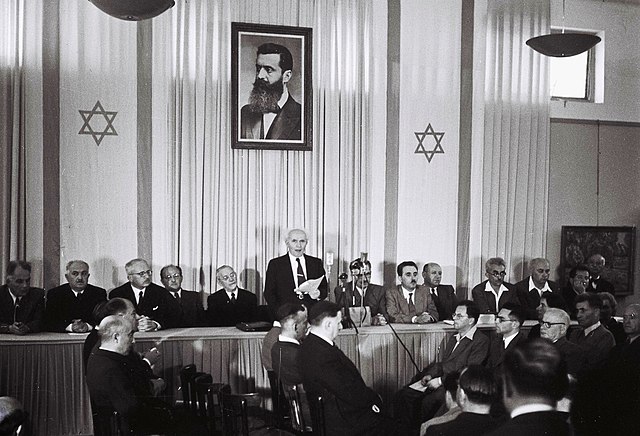In his superb series on Israel’s declaration of independence, Martin Kramer brings to life the circumstances and calculations behind the document’s drafting. This response will address its legal significance—internationally, in establishing Israel’s borders, and domestically, in establishing constitutional principles. To summarize: the declaration does none of those things.
As Kramer demonstrates, the declaration was intended primarily as an international legal and persuasive document, announcing the establishment of a new state on the world stage. The famous declaration of the American colonies in 1776 was not just a general inspiration, but a very specific one. One of the most fascinating details in Kramer’s history is that the Israeli document’s first draft began with the U.S. Declaration, translated into Hebrew and modified. While the particular language was abandoned almost entirely in subsequent drafts, the purpose remained to announce to the world that the Jewish state was assuming what its American equivalent called a “separate and equal station” in the world, empowered to do all the “Acts and Things which Independent States may of right do.”
The new state would be “like all other nations” in matters of sovereignty. That means it would not be any kind of protectorate or ward of the United Nations. Kramer details how the drafters nodded repeatedly at the UN General Assembly’s 1947 partition proposal, but only as one among many sources of legitimacy, subsidiary to the Jewish people’s natural and historic rights. Ben-Gurion in particular, Kramer shows, wished to capitalize on the UN’s limited toleration Jewish sovereignty, while rejecting lawyerly attempts to tie the new state’s fate to the UN. As a result, the declaration, and its insistence on sovereign equality, carried with it international legal consequences that continue to govern Israel’s principle geopolitical challenges.
The primary legal consequence involves the borders of Israel. As a state, Israel’s borders would be governed by the same rules as other countries. Those rules are simple and well-known. According to a doctrine of international law known as uti possidetis juris (literally, “as you possess under law”), a newly created state inherits the borders of the last top-level administrative unit in the area. Thus the emergence of a new nation does not result in a wholesale redrawing of boundaries based on demographic, historical, or other considerations. Rather, the new boundaries will be those of the pre-independence province, colony, district, or similar political entity. Any other rule would be a recipe for endless border conflicts both internally and with neighboring states.
For example, upon its independence, Ukraine inherited the borders of the Ukrainian Soviet Socialist Republic, including majority Russian-speaking areas that might have preferred union with Russia. In the context of the mandatory territories established by the League of Nations, new states like Iraq inherited the complete borders of the prior British mandate. While this principle has had consequences for the Kurds that may be lamentable, there is nothing even remotely controversial, from a legal standpoint, about those consequences.
The declaration of independence established Israel as the only state to arise in former mandatory Palestine. It said nothing of a claim to the full borders of Mandatory Palestine because it did not need to. The declaration purposefully left Israel open to the operation of international default rules like uti possidetis juris.
It is also relevant to note the declaration of independence that did not happen: a Palestinian Arab one. As Kramer shows, the Israeli document was the product of a brief but intense process by a highly organized political community. During this process, it had to reflect on the nature of its claims, the Jews’ historical connection to the land, and the character of the future state. Ben-Gurion brokered compromises among various sectors of society, primarily between religious and secular. No such process occurred on the Arab side. Instead of declaring independence for themselves, Palestinians largely attached themselves to the efforts of existing Arab states to destroy the Jewish one.
This is extremely consequential. Had they declared independence at the time, as many national-liberation movements were doing around the world, there would be two governments claiming the same borders for a sovereign state. Such situations are not uncommon—see, for instance, Libya today—and typically resolved by force of arms. But in law as in life, showing up is important. The Jewish community declared a state, and thus that state is Israel, not Palestine.
Indeed, the Palestinians did not declare independence for another 40 years. The declaration by the Palestine National Council in 1988, at the height of the intifada, is a useful contrast with Israel’s. For one, the Palestinians have no reluctance to base their declaration on explicitly religious principles. (“In the name of God, the Compassionate, the Merciful,” is how that document begins.) As Kramer explains, the Jews sought a more neutral wording in the phrase “Rock of Israel.”
The Israeli declaration’s several references to UN Resolution 181 lead some to argue that Israel only announced independence within the partition-plan borders. As a textual matter, this reading is odd, because the words “Eretz Israel” are also used repeatedly. But in neither case are these terms used in relation to borders, and Kramer shows this was no accident. One of the most important contributions of Kramer’s work is to show how studiously the provisional government rejected suggestions to specify borders.
Some lawyers involved in the drafting insisted that the declaration specify borders. Speaking with the complete assurance of today’s Israeli jurists, the future justice minister insisted it was “impossible” for a declaration of independence not to address borders. Ben-Gurion did not defer to this expertise. There can’t be a “law” that such a declaration must specify borders—witness the American one, which made no reference. Indeed, America’s borders with the British empire would only be resolved over 70 years after independence, in the Webster-Ashburton Treaty. Ben-Gurion’s reference to America shows the great influence that instrument had on Israel’s drafters, but he could as well have cited Burma and Ceylon, which had become independent from Britain in the prior months, or Ho Chi Minh’s declaration for Vietnam (1945), or the Indian 1930 Purna Swaraj.
Today, Ben-Gurion’s refusal to defer to government lawyers’ advice would be seen as insubordination, and worse, an assault on the “rule of law.” Indeed, the Supreme Court of Israel has decreed that it is presumptively unreasonable for an official to go against the instructions of his legal advisers. Yet had Ben-Gurion been thus bound, the Supreme Court, and the Knesset, would not be sitting in Jerusalem today.
As Kramer shows, the declaration’s legal meaning was reserved for the international realm. It was not understood as, or intended to be, a law, let alone a constitution. It was written in a great hurry, under an inflexible diplomatic deadline. It lacked all of the deliberation expected of constitutional instruments, and was not subject to prior public scrutiny. Indeed, its very name—which in Hebrew means “Announcement of the Establishment of the State of Israel”—indicates that it is not a document of governance. Yet half a century after the declaration, the Supreme Court has begun treating it as a constitutional document—that is, a basis to overturn Knesset legislation. The court’s former president, Aharon Barak, has gone even further, arguing that the declaration trumps Basic Laws themselves, effectively transforming it into an unamendable super-constitution.
Some textual basis for this was provided by the 1992 Basic Law: Human Dignity. Its preamble says that rights shall be “upheld in the spirit of the principles set forth in the Declaration of the Establishment of the State of Israel.” But this statement is a far cry from constitutionalizing the declaration, as the phrases “in the spirit” and “of the principles” make clear. Moreover, the principles of the declaration or too vague to be useful even as interpretive tools. What are the principles of “freedom, justice, and peace as envisaged by the prophets of Israel”? Surely these could involve indentured servitude, the death penalty, criminal regulation of sexual morality, compulsory war to reconquer Israel, and severe punishment of defeated enemies.
Of course, those are not the principles the Israeli Supreme Court means when it employs the declaration to interpret the constitution. For them it means something closer to “modern Western European social-justice ideas that we like.” And that is precisely the problem with the Supreme Court’s effort to constitutionalize the declaration: there is nothing to give legal effect to. The justices embrace the declaration specifically because they can find in it whatever principles suit them.
In the U.S., the expansive language of the declaration has also inspired efforts to constitutionalize it, but they have fared quite differently. Given that both the Israeli declaration and Israel’s use of judicial review are explicitly modeled on their American counterparts, it is useful to consider how the American declaration has been used as a tool of constitutional interpretation.
Despite mentioning in its preamble a broad range of liberal principles—”unalienable rights” and so forth—the U.S. Declaration of Independence is not used by courts as a guide to constitutional interpretation. Leading constitutional treatises, starting with Justice Joseph Story’s seminal 1833 Commentaries on the Constitution, barely mention the Declaration. It is understood to be a foreign-policy instrument, not one of domestic law.
Yet the Declaration has been embraced by reformers for some of the same reasons as Israel’s: it contains a reference to “equality,” missing from the U.S. Constitution. This led critics of slavery, most eloquently Abraham Lincoln, to invoke it in demonstrating that the institution contradicts America’s founding principles.
Yet Lincoln did not appeal to the Declaration as a basis for judicial power as much as for popular and political action—living up to its spirit by not extending slavery through legislation to new territories or in any other way. Indeed, it ultimately required the ratification of a new constitutional amendment, the fourteenth, to enshrine a principle of equality in the Constitution. The Supreme Court still does not strike down legislation for violating such “unalienable rights” as the “pursuit of happiness.” These rights are underspecified, and their invocation in the Declaration was never meant to make the American people subject to the whims of the judiciary rather than of King George.
Israel’s declaration, eloquent though it is, was drafted much more hurriedly and by authors lacking the stature of Thomas Jefferson. There is no reason it should have greater authority as a legal document than its famous model.
First published in Mosaic Magazine (“Why the Declaration of Independence is Not, and Should Not Be, Israel’s Constitution: Two Views”, Nov 22, 2021)




